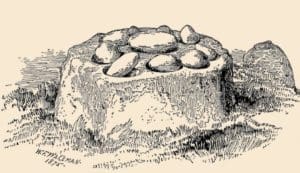Irish Lace Making History: Unravelling the Threads of a Time-Honoured Craft

Updated On: April 22, 2024 by Ciaran Connolly
Irish lace making boasts a history woven with cultural resilience and artistic finesse, deeply rooted in Ireland’s legacy. Often characterised as a luxury commodity, Irish lace began as a form of economic relief, helping numerous families combat poverty, especially during the Irish Famine. The intricate designs of lace were traditionally used to adorn wedding dresses, christening gowns, and religious vestments, reflecting the social significance and craftsmanship that have been central to Irish culture.

The emergence of Irish lace coincides with moments of great adversity in Ireland’s past. Through the establishment of lace-making schools and initiatives, the craft offered a sustainable source of income to the impoverished. The versatility of Irish lace sees its existence in several types, including the famed Crochet, Carrickmacross, and Limerick lace, each distinguished by unique techniques, materials, and patterns. This lace has not only shaped the local Irish economy but has also left its mark on the fashion industry, as both vintage and modern design continue to celebrate its delicate beauty.
Key Takeaways
- Irish lace making has a rich history that played a vital economic role during the 19th century.
- Different types of Irish lace exhibit unique craftsmanship inherent to Ireland’s cultural heritage.
- The art of lace making has influenced both historical and contemporary fashion trends.
Origins and Historical Significance

In the tapestry of Irish culture, the art of lace-making weaves a rich history that is interlaced with both the economic shifts and inventive spirit of the Irish people.
Irish Lace in the 18th Century
In the 18th century, lacemaking developed in Ireland as a craft capable of providing economic support to families, particularly for young women. With the establishment of the Dublin Society in 1731, which later became the Royal Dublin Society, efforts were amplified to promote various industries, including lacemaking, as means to bolster the economy.
The Great Famine and Lace Making
During the Great Famine, from 1845 to 1849, lacemaking became a vital source of income. Poverty stricken, but resolute, the Irish people turned to the intricate craft as a means of survival. Lacemaking required minimal equipment and became a suitable occupation for those residing in remote areas of Ireland, where employment opportunities were scarce and the presence of industry was almost non-existent.
Major Types of Irish Lace
Irish lace is revered worldwide for its intricate craftsmanship and delicate beauty. In this section, we explore the significant types of Irish lace that have been woven into the fabric of Ireland’s artisanal heritage.
Limerick Lace
Limerick lace, also known as Tambour lace due to its manner of manufacture using a small hoop called a tambour, emerged around the 1830s. Recognised for its fine net background and intricate embroidered patterns, it became one of the most famous Irish laces, especially during times of hardship when it was a means for women to support their families.
Carrickmacross Lace
Originating in the 18th century, Carrickmacross lace is characterised by its appliqué technique on a fine net, creating a distinct lace that is simultaneously robust and elegant. This method involves laying intricate patterns on the net and then painstakingly trimming the excess fabric, resulting in beautiful designs.
Youghal Lace
Youghal lace is a type of needlepoint lace similar to Venetian Point lace, with a strong influence from the Italian lace-making tradition. It thrived in the town of Youghal, County Cork, during the 19th century, earning admiration for its high-quality and elaborate patterns.
Kenmare Lace
Kenmare lace is recognised for its delicate and floral designs, often reflecting nature’s influence on the craft. Established by the Poor Clare Nuns in Kenmare in the 19th century, Kenmare lace is a type of needlepoint lace with exquisite detail, contributing significantly to the town’s economy.
Irish Crochet Lace
Renowned for its raised floral patterns that resemble three-dimensional artworks, Irish crochet lace was particularly popular during the 19th century. This needlework art form involves creating individual motifs crafted with a fine hook before they are joined together with a net-like mesh, resulting in a unique lace revered for its beauty and texture.
We find satisfaction and pride in recounting the rich lineage of our nation’s lace-making, a tradition that has not only enhanced Ireland’s reputation in the textile world but has also been a symbol of the resilience and skill of its people. Each of these laces holds a story, resonating with the history of the communities that crafted them, and has secured a treasured place within our cultural tapestry.
Techniques and Materials

We’ll be exploring the intricate craftsmanship and resources that constitute Irish lace-making, focusing on the precise methods as well as the traditional materials employed.
Crochet and Needlepoint Techniques
Crochet: This method involves creating lace with a small hooked needle, crafting loops and chains to build up intricate patterns. Irish crochet is renowned for its fine detailing, which often features floral and leaf motifs, brought to life through techniques such as the Clones knot. The lace made in this fashion was traditionally a signifier of wealth and status in Europe, and it contributed significantly to the Irish economy during times of hardship.
Needlepoint: Unlike crochet, needlepoint lace requires the use of a sharp needle and a pattern outlined on a pillow or stiff backing. It’s a painstaking process where thread is woven to fill in the design’s outlines, producing a delicate and highly decorative mesh.
Cotton and Linen Thread
Cotton: The primary material for Irish lace, particularly in crochet, is cotton thread. Its fine quality allows for the creation of detailed and complex designs that are both durable and aesthetically pleasing.
Linen Thread: Occasionally, linen thread is also employed in lace-making for its natural sheen and strength. This thread complements cotton, especially in varieties of needlepoint lace, where its characteristics enhance the lace’s texture and durability.
Geographical Spread and Influence

Lace-making, an intricate craft, was centred in pockets of Ireland and garnered global admiration for its detailed beauty.
Lace Making in Cork and Kerry
In County Cork and County Kerry, we find a rich history of lace production, with each locale cultivating its unique styles. Cork was renowned for its fine, ornate lacework, influencing lace trends in cosmopolitan areas. Society benefited from this skill, as it offered an economic boost through its domestic and cross-border trade. Kerry, with its own distinct methods, contributed to the lush tapestry of Irish lace, leaving a lasting cultural imprint.
International Recognition
The charm of Irish lace quickly transcended Irish shores, reaching as far as London, France, and Italy. Its reception in London’s fashion scene solidified its status, while across France and Italy – homes to their own storied traditions of lace – Irish lace was met with fascination and reverence. Its spread highlighted the impact of Irish cultural crafts on the international stage.
Cultural and Social Impact
In this section, we explore the rich cultural tapestry and social significance of Irish lace, highlighting its role in shaping Irish identity and the profound impact it had on the lives of women who contributed to this fine craft.
Lace and Irish Identity
Lace-making in Ireland is more than a craft; it is a storied tradition that weaves deeply into the fabric of our national identity. Historically, Irish lace became synonymous with cultural sophistication and played a pivotal role in reflecting the social hierarchy. It adorned the garments of the wealthy, thus becoming a symbol of high status in Europe. Moreover, the unique designs of Irish lace contributed to a sense of national pride, as they often featured patterns inspired by our local flora and historical symbols.
Women’s Role in Lace Making
Certainly, women were the cornerstone of Irish lace making, their skilled hands meticulously creating each piece. During times of hardship, especially the Great Famine, lace making provided a crucial source of income, lifting many out of destitution. Organisations led by women, such as those influenced by Lady Aberdeen, became instrumental in promoting the craft both domestically and internationally. The industry not only empowered women economically but also fostered a strong sense of community among them, as they gathered to create, sell, and pass on their skills to the next generation. In essence, Irish lace became a thread that connected the women of Ireland to the broader tapestry of society.
Industrialisation and Cottage Industry

In the transformation of Irish lace making, industrialisation played a pivotal role while cottage industries sustained the craft at a critical time.
Transformation to a Structured Industry
The Irish lace industry saw a significant shift with the advent of the Industrial Revolution. Mechanisation introduced new methods that increased production capacities and transformed lace into a widely accessible commodity. However, the charm of handcrafted Irish lace remained unparalleled, and so the industry adapted by structuring the handicraft into formalised networks, fostering the rise of specialised lace-making centres throughout Ireland, each known for their unique patterns and techniques.
Cottage Industry During the 19th Century
Lace-making, as a cottage industry in the 19th century, was a key means of livelihood for many Irish families, especially during famine. Families were able to generate income by creating intricate lace designs in their own homes, which were then sometimes sold both locally and internationally. This cottage industry became a vital economic force, particularly for those in rural areas, and played a crucial role in sustaining the community through challenging times. The Irish lace produced during this period was renowned for its exquisite craftsmanship and was sought after across Europe.
Lace in Fashion and Society

Lace has long been a symbol of elegance and fine taste within high society and fashion, often seen gracing the garments of royalty and the wealthy. It has evolved with fashion cycles and maintains a presence in modern attire.
Royal Influence and Fashion Cycles
Historically, Queen Victoria’s decision to wear a wedding dress adorned with lace had a lasting impact on bridal fashion, making lace gowns a prevalent choice for weddings. Lace’s popularity waxes and wanes with fashion cycles, but its association with formality and luxury remains steadfast.
Lace in Modern Attire
In contemporary fashion, lace continues to add a touch of luxury to formal designs. From being a staple in modern wedding dresses to its incorporation into everyday wear, lace subtly conveys a sense of sophistication and tasteful style. It hints at tradition while seamlessly blending with current trends.
Education and Preservation

The preservation of Irish lace making tradition hinges on sustained educational efforts and the showcasing of its historical significance in museums. Through education, we ensure the continuation of this delicate art form, and exhibitions offer a window into its past relevance and beauty.
Teaching of Lace Making
Lace making once flourished as a skill that provided a lifeline to Irish families, particularly during times of economic hardship. Today, we recognise the importance of its preservation through education at institutions such as the Crawford Municipal School of Art, where lace-making techniques like those used for Limerick Lace are not only taught but also celebrated as part of Ireland’s cultural heritage. The Dublin Society, now known as the Royal Dublin Society, has historically played a pivotal role in the promotion of lace making as a valued industry in Ireland, helping to ensure that the craft not only survives but also thrives with each new generation.
Museums and Exhibitions
Museums and exhibitions stand as testaments to the intricate beauty of Irish lace. The Limerick Museum is a prime example, where the public can view delicate pieces of local craftsmanship. Similarly, prestigious international collections such as those at the Victoria and Albert Museum in London serve to highlight the global importance of Irish lace, framing it within the broader context of textile art and history. These exhibitions allow us to connect with our heritage and the stories embedded in each intricately woven pattern.
Innovation and Modern Lacemaking

As we explore the evolution of Irish lacemaking, our focus is on the contemporary advancements in both design and technique, as well as the vision of lacemaking’s future.
Contemporary Design and Techniques
In recent years, we’ve observed a remarkable transformation in Irish lacemaking, with artisans blending traditional patterns with modern designs. These innovative approaches are keeping the craft vibrant and relevant. For instance, digital tools are now employed to create intricate lace patterns that were once drawn by hand. This intersection of heritage and high-tech has inspired a new wave of lace design, broadening the spectrum of this age-old craft to appeal to contemporary aesthetics.
Future of Irish Lacemaking
Looking ahead, the future of Irish lacemaking appears promising, as it adapts to the changing tastes and technologies of the times. Emphasising the need for innovation while honouring tradition, new generations of artisans are approaching lacemaking as both a recreational activity and a sophisticated craft. With sustainability in mind, there is a strong emphasis on using ethically sourced materials. Programmes aimed at teaching lacemaking to younger enthusiasts ensure the skill is preserved and passed down, securing the legacy of Irish lace for years to come.
Economic and Philanthropic Aspects

The intricate craft of Irish lace not only holds a rich cultural significance but also showcases the intertwined roles of philanthropy and economics in its history. These aspects were crucial in sustaining and empowering communities through times of hardship.
Philanthropy Aiding Lace Schools
Philanthropic efforts, particularly in the 19th century, played a pivotal role in the establishment of lace schools across Ireland. Noteworthy among these contributors was the Irish Industries Association, which aimed to revive and promote traditional Irish crafts amid economic struggles. The association, alongside individuals like Alan Cole and Charles Walker, recognised the potential of lace making to provide economic relief. They set up schools where women could learn the skill, thus fostering self-sufficiency and enabling them to earn an income.
The Lace Market and Economy
Irish lace quickly became a sought-after luxury item, gracing the fashion of Europe’s wealthy elite. Its market thrived, bringing economic benefits to the lace makers, often impoverished women who found a vital source of income in this intricate art. Charitable action and commercial interest combined to establish a self-sustaining market. The economic fabric of Irish lace was strengthened by the dual forces of philanthropy, fuelling the trade, and the free market, responding to the high demand for this luxury product.
Frequently Asked Questions

Irish lace has a rich tapestry of history and an intricate set of styles and patterns that have charmed people around the world. The following are some of the most common questions asked about this exquisite craft.
What are the origins of Irish crochet lace?
Crochet lace was introduced to Ireland in the 19th century to help alleviate poverty. It quickly became a form of artistic expression for Irish women, particularly during the famine years.
In which period did lace making flourish in Ireland?
Lace making flourished during the 19th and early 20th centuries, when Irish lace was esteemed as a luxury item across Europe.
What are the distinctive features of traditional Irish lace?
Traditional Irish lace is known for its delicate patterns, fine workmanship, and often features floral motifs, which are inspired by the Irish countryside.
How did Irish lace making impact the economy during its peak?
During its heyday, Irish lace making significantly contributed to the Irish economy by providing employment for many, especially women, thus helping numerous families navigate financial hardships.
What are the various styles and patterns unique to Irish lace?
Styles such as Carrickmacross, Youghal, and Limerick are unique to Irish lace, each with distinctive techniques and designs, from appliqué to needlework.
How has Irish lace making evolved from its historical beginnings to the present day?
From a means of survival to a celebrated craft, Irish lace making today is both a cherished hobby and a symbol of cultural heritage, linking the past to contemporary fashion and design.






